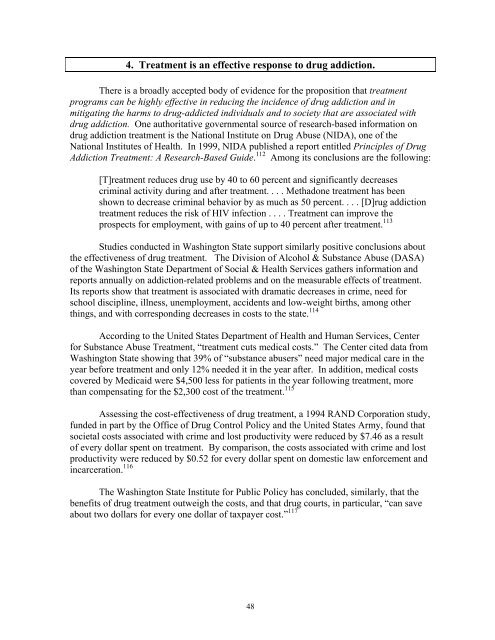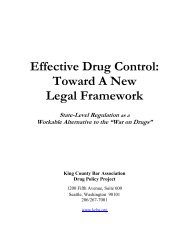Is It Time to End the War on Drugs? - King County Bar Association
Is It Time to End the War on Drugs? - King County Bar Association
Is It Time to End the War on Drugs? - King County Bar Association
You also want an ePaper? Increase the reach of your titles
YUMPU automatically turns print PDFs into web optimized ePapers that Google loves.
4. Treatment is an effective resp<strong>on</strong>se <str<strong>on</strong>g>to</str<strong>on</strong>g> drug addicti<strong>on</strong>.There is a broadly accepted body of evidence for <str<strong>on</strong>g>the</str<strong>on</strong>g> propositi<strong>on</strong> that treatmentprograms can be highly effective in reducing <str<strong>on</strong>g>the</str<strong>on</strong>g> incidence of drug addicti<strong>on</strong> and inmitigating <str<strong>on</strong>g>the</str<strong>on</strong>g> harms <str<strong>on</strong>g>to</str<strong>on</strong>g> drug-addicted individuals and <str<strong>on</strong>g>to</str<strong>on</strong>g> society that are associated withdrug addicti<strong>on</strong>. One authoritative governmental source of research-based informati<strong>on</strong> <strong>on</strong>drug addicti<strong>on</strong> treatment is <str<strong>on</strong>g>the</str<strong>on</strong>g> Nati<strong>on</strong>al Institute <strong>on</strong> Drug Abuse (NIDA), <strong>on</strong>e of <str<strong>on</strong>g>the</str<strong>on</strong>g>Nati<strong>on</strong>al Institutes of Health. In 1999, NIDA published a report entitled Principles of DrugAddicti<strong>on</strong> Treatment: A Research-Based Guide. 112 Am<strong>on</strong>g its c<strong>on</strong>clusi<strong>on</strong>s are <str<strong>on</strong>g>the</str<strong>on</strong>g> following:[T]reatment reduces drug use by 40 <str<strong>on</strong>g>to</str<strong>on</strong>g> 60 percent and significantly decreasescriminal activity during and after treatment. . . . Methad<strong>on</strong>e treatment has beenshown <str<strong>on</strong>g>to</str<strong>on</strong>g> decrease criminal behavior by as much as 50 percent. . . . [D]rug addicti<strong>on</strong>treatment reduces <str<strong>on</strong>g>the</str<strong>on</strong>g> risk of HIV infecti<strong>on</strong> . . . . Treatment can improve <str<strong>on</strong>g>the</str<strong>on</strong>g>prospects for employment, with gains of up <str<strong>on</strong>g>to</str<strong>on</strong>g> 40 percent after treatment. 113Studies c<strong>on</strong>ducted in Washing<str<strong>on</strong>g>to</str<strong>on</strong>g>n State support similarly positive c<strong>on</strong>clusi<strong>on</strong>s about<str<strong>on</strong>g>the</str<strong>on</strong>g> effectiveness of drug treatment. The Divisi<strong>on</strong> of Alcohol & Substance Abuse (DASA)of <str<strong>on</strong>g>the</str<strong>on</strong>g> Washing<str<strong>on</strong>g>to</str<strong>on</strong>g>n State Department of Social & Health Services ga<str<strong>on</strong>g>the</str<strong>on</strong>g>rs informati<strong>on</strong> andreports annually <strong>on</strong> addicti<strong>on</strong>-related problems and <strong>on</strong> <str<strong>on</strong>g>the</str<strong>on</strong>g> measurable effects of treatment.<str<strong>on</strong>g>It</str<strong>on</strong>g>s reports show that treatment is associated with dramatic decreases in crime, need forschool discipline, illness, unemployment, accidents and low-weight births, am<strong>on</strong>g o<str<strong>on</strong>g>the</str<strong>on</strong>g>rthings, and with corresp<strong>on</strong>ding decreases in costs <str<strong>on</strong>g>to</str<strong>on</strong>g> <str<strong>on</strong>g>the</str<strong>on</strong>g> state. 114According <str<strong>on</strong>g>to</str<strong>on</strong>g> <str<strong>on</strong>g>the</str<strong>on</strong>g> United States Department of Health and Human Services, Centerfor Substance Abuse Treatment, “treatment cuts medical costs.” The Center cited data fromWashing<str<strong>on</strong>g>to</str<strong>on</strong>g>n State showing that 39% of “substance abusers” need major medical care in <str<strong>on</strong>g>the</str<strong>on</strong>g>year before treatment and <strong>on</strong>ly 12% needed it in <str<strong>on</strong>g>the</str<strong>on</strong>g> year after. In additi<strong>on</strong>, medical costscovered by Medicaid were $4,500 less for patients in <str<strong>on</strong>g>the</str<strong>on</strong>g> year following treatment, morethan compensating for <str<strong>on</strong>g>the</str<strong>on</strong>g> $2,300 cost of <str<strong>on</strong>g>the</str<strong>on</strong>g> treatment. 115Assessing <str<strong>on</strong>g>the</str<strong>on</strong>g> cost-effectiveness of drug treatment, a 1994 RAND Corporati<strong>on</strong> study,funded in part by <str<strong>on</strong>g>the</str<strong>on</strong>g> Office of Drug C<strong>on</strong>trol Policy and <str<strong>on</strong>g>the</str<strong>on</strong>g> United States Army, found thatsocietal costs associated with crime and lost productivity were reduced by $7.46 as a resul<str<strong>on</strong>g>to</str<strong>on</strong>g>f every dollar spent <strong>on</strong> treatment. By comparis<strong>on</strong>, <str<strong>on</strong>g>the</str<strong>on</strong>g> costs associated with crime and lostproductivity were reduced by $0.52 for every dollar spent <strong>on</strong> domestic law enforcement andincarcerati<strong>on</strong>. 116The Washing<str<strong>on</strong>g>to</str<strong>on</strong>g>n State Institute for Public Policy has c<strong>on</strong>cluded, similarly, that <str<strong>on</strong>g>the</str<strong>on</strong>g>benefits of drug treatment outweigh <str<strong>on</strong>g>the</str<strong>on</strong>g> costs, and that drug courts, in particular, “can saveabout two dollars for every <strong>on</strong>e dollar of taxpayer cost.” 11748
















